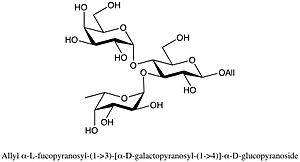Oligosaccharide facts for kids
An oligosaccharide is a type of carbohydrate (which are also known as sugars). Think of it like a small chain made of a few simple sugar units linked together. When these chains are broken down, they usually give you between 2 and 9 smaller sugar units called monosaccharides.
Contents
What are Oligosaccharides?
Oligosaccharides are a group of carbohydrates. They are bigger than single sugar units (monosaccharides) but smaller than very long sugar chains (polysaccharides). The word "oligo" means "a few," and "saccharide" means "sugar." So, an oligosaccharide is literally "a few sugars."
How Oligosaccharides are Formed
Oligosaccharides are made when 2 to 9 simple sugar units (monosaccharides) join together. This happens through a special chemical bond called a glycosidic linkage. When these units connect, a small water molecule is removed. It's like building with LEGOs: each sugar unit is a brick, and when you snap them together, you form a chain.
Breaking Down Oligosaccharides
Just as oligosaccharides are formed, they can also be broken down. This process is called hydrolysis. It's the opposite of how they are made. When an oligosaccharide is mixed with water, and usually with the help of an acid or a special protein called an enzyme, the glycosidic linkages break. This releases the individual monosaccharide units that made up the chain.
Types of Oligosaccharides
Oligosaccharides are named based on how many simple sugar units they contain:
- Disaccharides: These are oligosaccharides made of exactly two monosaccharide units. A common example you might know is sucrose (table sugar), which is made of glucose and fructose. Another one is lactose (milk sugar), made of glucose and galactose.
- Trisaccharides: These contain three monosaccharide units.
- And so on, up to nonasaccharides (nine units).
Where are Oligosaccharides Found?
Oligosaccharides are found in many places, both in nature and in our bodies.
- Plants: Many plants contain oligosaccharides. For example, some are found in beans, onions, and asparagus. These can be good for your digestion.
- Human Milk: Human breast milk contains special oligosaccharides that help feed good bacteria in a baby's gut. This helps the baby's immune system grow strong.
- Cell Surfaces: Oligosaccharides are also found on the surface of cells in our bodies. They act like little flags or ID tags that help cells recognize each other. This is important for many body functions, like how your immune system works.
Why are Oligosaccharides Important?
Oligosaccharides play several important roles:
- Energy: Like other carbohydrates, they can be a source of energy for the body.
- Prebiotics: Some oligosaccharides are known as prebiotics. This means they are food for the good bacteria that live in your gut. These good bacteria help with digestion and overall health.
- Cell Communication: As mentioned, they help cells talk to each other and recognize harmful invaders.
Images for kids
See also
 In Spanish: Oligosacárido para niños
In Spanish: Oligosacárido para niños




